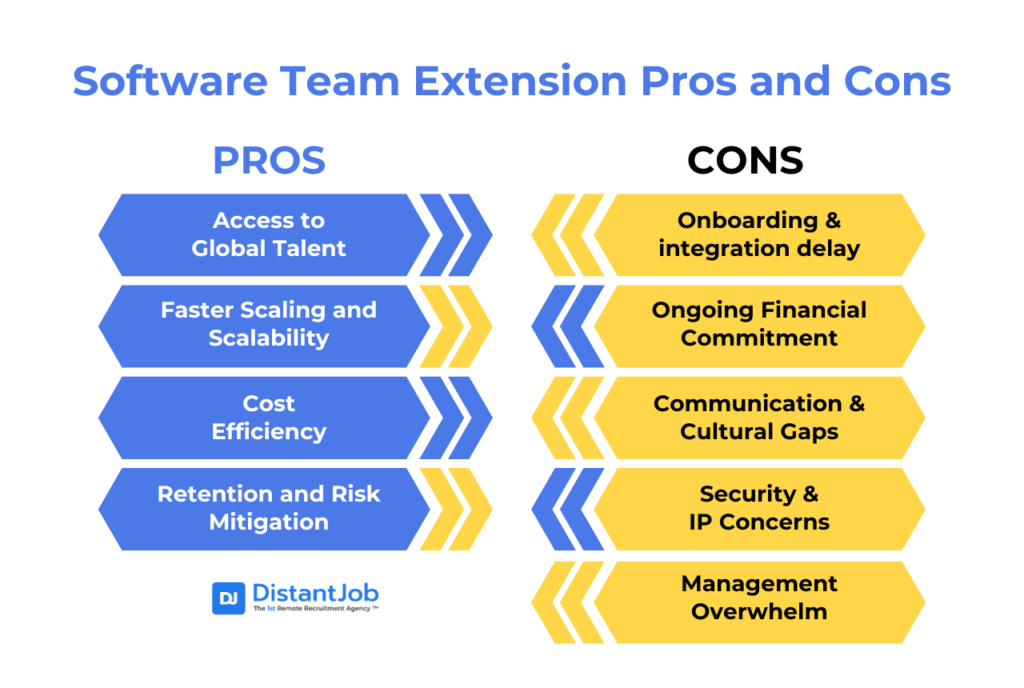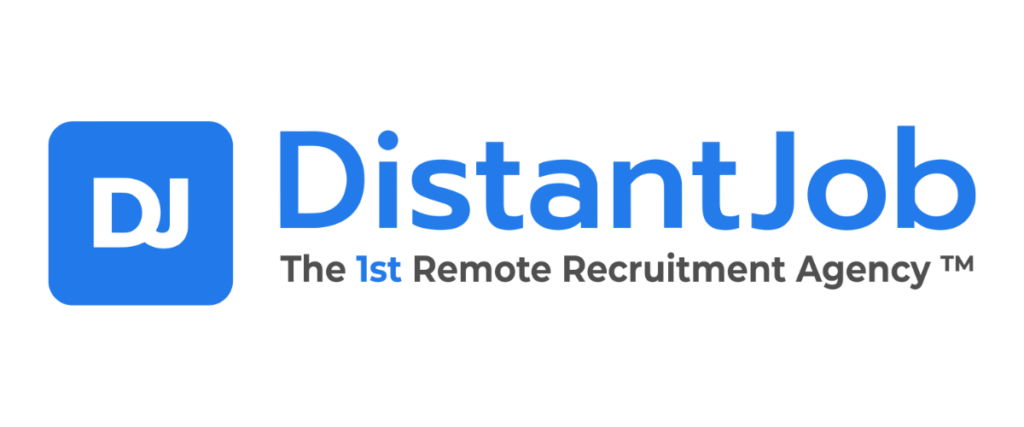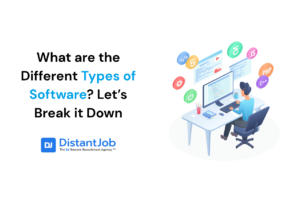With a global shortage of over 85 million tech workers expected by 2030—costing businesses nearly $8.5 trillion annually, according to the IMF—companies must rethink their approach to software development staffing. This is where team extension, also known as outstaffing, comes into play. Team extension is a flexible hiring model that allows businesses to seamlessly integrate external developers directly into their existing teams. Unlike traditional outsourcing, this model provides direct oversight, ensures cultural alignment, and enhances productivity without the long-term financial commitment of permanent hires.
I’ve always thought there was something strange about team extension. Maybe there is something wrong with the outsourcing industry as a whole. Indeed, sometimes your software development team needs an upgrade, and you don’t have the budget for hiring. Tons of outsourcing companies come at you and offer you a software team extension model.
But is team extension the right solution to navigate this growing tech talent gap? Let’s explore how this strategy can effectively scale and strengthen your software development team.
What Is the Team Extension (Outstaffing) Model?
The Team Extension is a collaboration model in which a company temporarily extends its internal software development team. The company adds one or more developers who will work as part of the team.
Despite outsourcing companies offering extensions as a service, you can provide a DIY Team Extension at your company, provided you have a dedicated HR team.
By using a team extension model, you get external software developers to join your team. They will fill skill gaps or increase capacity, working under your leadership.
The key features of team extension include:
- They won’t have exclusive clients, just you, so full commitment.
- The extension team will participate in the same workflow as your team (meetings, sprints, etc.)
- They respond to you, not to anyone else. you have direct control.
- No Administrative Burden (if outsourcing company is involved): payment, hiring, contracts, and workspace are handled by your contracting party. If you are DIY, you will have to handle them as well.
Consider start-ups. For them, speed to market is critical, and lengthy recruitment of local senior developers can be a bottleneck. After all, not every city has tons of seniors available.
Smaller companies and SaaS start-ups often turn to team extension when rapid growth outpaces their hiring ability or budget. As I stated earlier, big companies are also outstaffing their teams.
Team Extension vs Project Outsourcing vs Staff Augmentation vs In-house Hiring
When expanding your software team, you need to take into consideration and understand your staffing options.
While team extension involves integrating external talent directly into your internal team, allowing full managerial control and seamless collaboration, project outsourcing delegates the entire management and execution of projects to external agencies, limiting your direct oversight.
Then we have staff augmentation, which is similar to team extension but usually refers to temporary engagements focused on filling specific skill gaps or short-term needs. Finally, in-house hiring means recruiting full-time employees internally. This provides the highest degree of control and alignment but also involves significant time and financial investments.
Each approach has distinct benefits, depending on your project’s timeline, budget, desired control level, and strategic goals.
Here is a comparison between team extension and other forms of hiring to give you a better understanding of each:
| Team Extension (Outstaffing) | Project Outsourcing | Staff Augmentation | In-House Hiring | |
| Cost Model | Monthly or hourly per developer (vendor adds margin) – e.g., nearshore dev at lower cost | Contractual (fixed project fee or T&M hourly for team) – cost for deliverable | Hourly/contract rate per contractor (often high hourly) | Salary + benefits + overhead (highest long-term cost) |
| Who Manages Work | Client manages daily tasks, sprint planning, etc. (extended devs report to client’s PM/CTO) | Vendor manages the project and team, client checks milestones/results | Client manages the contractor’s tasks directly (like any team member) | Client manages (employee is fully internal) |
| Integration Level | High: part of internal team meetings, follows internal processes | Low: separate team, possibly different process; integrated only at deliverables | Medium: works within the team during the contract, but temporarily and externally | Full: part of company org/culture, long-term integration |
| Hiring Speed & Ease | Fast: vendor presents candidates; client can scale team in weeks | Medium: need to scope project and find a capable vendor; can take time to kick off | Fast: can often onboard a contractor in days/weeks via agency or platform | Slow: Recruitment can take months for skilled hires, plus notice periods |
| Flexibility | It can scale team up or down with notice; end engagement when no longer needed (though typically long-term) | Flexible in scoping projects; easy to end after the project, but not flexible to change requirements without a contract change | Very flexible: end or extend contracts as needed; add more contractors short-term if budget allows | Rigid: scaling down means layoffs (costly), scaling up is limited by the recruiting pipeline |
| Knowledge Retention | Good (long term): extended team accumulates product knowledge; loss if the contract ends abruptly | Variable: knowledge may stay with vendor, not transferred fully to client (unless documentation/handoff) | Low (short-term): contractor may leave, taking their knowledge; often need knowledge transfer to employees at end | High: knowledge stays in-house with employees; they become domain experts over time |
| Upfront HR/Setup Effort | Low: provider handles recruiting, HR, admin; client just interviews/chooses devs | Low/Medium: effort spent in vendor selection and defining requirements, then vendor handles internals | Low: agency or platform finds candidates, though client may interview; paperwork minimal (except perhaps NDAs) | High: HR and managers spend significant effort sourcing, interviewing, hiring, and onboarding each employee |
| Control over Process | High: full control over development process, task priorities, coding standards, etc. (team extension devs follow client’s directives) | Low: control over final outputs via contract, but day-to-day process is vendor’s responsibility (unless it’s a very collaborative model) | High: direct control (contractors follow the client’s instructions, same as employees in tasks) | High: direct control (they are internal) |
| Commitment Duration | Medium to long: often ongoing engagement; best for multi-month or multi-year needs. Ending early might require notice as per the contract. | Short to medium: typically ends at project completion or term. Can be extended via new contracts if needed. | Short: often a few weeks to months, can be extended or cut quickly (depending on contract terms). | Long: indefinite employment until separation; ideally years. |
| Key Benefits | Access to talent and scale quickly without full hiring cost, while maintaining control and internal coordination. Also offloads HR burden. | Turnkey delivery, minimal management required; the vendor brings expertise often in delivering similar projects. The client can focus on other things. | Extremely quick in adding skills; you pay only for what and when you need. Try out talent or fill the gap quickly. | Strong team cohesion, cultural alignment; maximum IP security; employees are often more dedicated. Good for long-term stability and building company know-how. |
| Key Drawbacks | Requires good remote team management; communication or time zone issues can arise. Continual cost (like staff) even if the project’s tempo fluctuates. | Less visibility and control; potential misalignment if requirements aren’t clear. Quality depends on the vendor’s diligence. Not ideal for evolving scope or core products. | Contractors may lack loyalty or context; they need oversight to ensure quality. High cost per hour; knowledge can leave abruptly. Legal considerations for long-term (to avoid misclassifying as an employee). | Often expensive and slow to scale. Risk of overstaffing if projects slow down. Hiring the wrong cultural fit is costly. Harder to terminate if performance issues (in comparison to ending a contract). |
What are the Pros and Cons of extending your software team
Companies that adopt software team extension get these advantages:

- Employers can deploy developers anywhere in the world.
- Scale up the team quickly and without much bureaucracy or burden.
- Team extension can reduce development cost compared to hiring solely U.S.-based devs. Companies save significantly by engaging skilled developers from lower cost countries (like Eastern Europe or Latin America) by around 30%-50%.
- Sharing the load with the extended team can prevent burnout from the core employees.
But let’s be honest here, you could get all those traits by simply going remote. 😉
As not everything is bees and flowers, there are disadvantages when it comes to software team extension as well.
- While you can hire faster, as extended teams are not a quick fix and they need time to adapt to your tools, product, and properly integrate with your main staff.
- Unlike traditional outsourcing, you have to pay them monthly per developer.
- Differences in language, company culture, or work hours may pose challenges.
- Companies must ensure security protocols, proper NDAs, and IP Protections when sharing code and data with an external team.
- Can your company really handle a bigger team? Your manager must have proper project management skills, or bottlenecks will appear.
When to Choose a Team Extension
You should consider a team extension service when your existing team faces skill gaps, tight project deadlines, or a sudden need for scalability. It’s particularly valuable if you require specialized expertise quickly, without the lengthy hiring process and high overhead costs associated with permanent in-house recruitment.
Team extension is ideal when you want direct management control, seamless integration into your current workflows, and the flexibility to scale your team up or down as project demands change.
How to Integrate an Extended Team Successfully
Bringing an external developer for an existing code base is not just an outsourcing function; it’s a change management process. Companies that combine thorough preparation, a simple remote onboarding process, and a 30/60/90 plan substantially reduce onboarding time and increase retention by 82%.
The best way to minimize onboarding time is to spend time preparing ahead of time.
- Send the developer her setup which includes a computer if necessary along with access to all the required systems a week or two before she starts. This alone could save a developer hours of work .
- Spend 1½ hours educating the new developer about the company, processes, and standards. Remote employees tend to be anxious that they are missing key information, so getting direct access to that will ease their mind .
- At the start, create a detailed 30/60/90 plan. This creates a smooth onboarding process that gets developers to work and produce faster (Atlassian).
- Limit communications to less than 2 hours and focus the rest of the relationship on asynchronous communication. This method is arguably more productive than the office environment that could be filled with regular distractions.
- Provide the developer with an “onboarding buddy,” who is responsible for responding quickly to new developer questions. Onboarding buddies are shown to decreaseemployee turnover by 50% .
Onboarding checklist
| When | Action Item | Owner | Done? |
|---|---|---|---|
| T‑14 days | Ship hardware or confirm BYOD specs; create cloud & repo accounts; schedule kickoff call | IT / PM | ☐ |
| T‑7 days | Send welcome email with agenda, orientation videos, coding guidelines, architectural diagram | HR | ☐ |
| Day 1 | Virtual team intro; pair laptop check; walkthrough of sprint board & CI/CD pipeline | Engineering Manager | ☐ |
| Day 1‑3 | Assign buddy; complete first “good first issue” merge; verify local test suite passes | Buddy / New Dev | ☐ |
| Week 1 | Attend daily stand‑ups; shadow code review; schedule first 1:1 feedback session | Scrum Master | ☐ |
| Week 2 | Independent ticket delivery; add documentation or tests; security training module complete | New Dev | ☐ |
| Day 30 | Review 30‑day OKRs; gather retro notes; adjust 60‑/90‑day goals | Engineering Manager | ☐ |
| Day 60 | Ownership of a minor feature or service; deliver brown‑bag talk on lessons learned | New Dev | ☐ |
| Day 90 | Performance check‑in; decide on long‑term role scope; celebrate milestones | CTO | ☐ |
Is there a best option out of there?
If only you could hire people for a cheaper price, getting all the benefits of a Software Team Extension and maybe more. Jeez, I wonder how delightful it would be if something like that actually existed.

Oh, wait, we have it! What a fortunate coincidence! 😁
You can hire the specialists of your dreams in Distant Job. You will get all those juicy benefits from a software team extension, but more:
| Benefits | Explanation |
| Lower Costs | Pay them less than they would cost in the US. |
| Flexibility | Hire specialists according to your needs. |
| A global pool of talent | Get the best specialists in the world, instead of just in your town. |
| Team Integration | Add specialists to your team instead of a third-party. |
| Control | Manage them directly instead of communicating through a contractor. |
| Team Collaboration | Maximize the team’s synergy instead of counting on an external team out of your control. |
| No Hidden Fees | No fine print. |
| Triple Approval Process | A 3-step evaluation and screening process ensures your new hires are top-quality hires. |
| Cultural Fit | Get a team that fits your company culture and your business’s needs. |
| Full Support | Forget about Law, HR, Compliance, and the hard stuff. We will cover that for you. |
| Employee Retention | Your employees’ well-being will be taken care of by us, making them want to stay. |
| Fast Hiring | In two weeks, you will have the remote employee of your dreams. |
As you may have noticed, we have covered all the flaws of the software team extension. We take care of your employee, we guarantee that he will be a cultural fit for your company, facilitating integration. We also provide consultancy so you can manage your team effectively and easily.
In short, we provide you with the key features and pros of the software team extension, and we don’t have its flaws. In fact, we get better employees for you with a guarantee of 100% of your money back, if you don’t like them in three months.
“You must be desperate to offer such a guarantee”. Nah, I just think you won’t need it.
Conclusion
Now you have learned why software team extensions have been adopted, grown, and spread. It has its benefits, and it’s totally worth a shot. However, I must add we are better in every way, so why don’t you contact us?
Let us know about your company’s needs!





